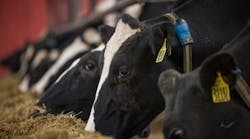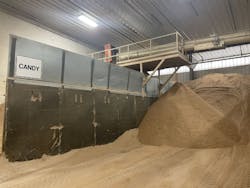Think of it as Kisses for cows.
Hershey Co.’s search for a use for chocolate manufacturing waste and Cargill Inc.’s ongoing pursuit of nutritious animal feed came together in a nice win-win for both companies, for both sustainability and economics.
Since the early 2000s, Hershey had been selling small quantities of the waste and byproduct from its plants on the open market after processing it themselves, mostly for animal feed. Cargill was one of those customers. But in 2011, Hershey told Cargill it wanted to exit that business; would the agribusiness giant like to take all of the chocolatier’s waste and turn it into animal feed?
Coincidentally, Cargill was in the process of rebuilding an animal feed manufacturing facility not too far away in Chambersburg, Pa., that had been destroyed by fire. That plant already had experience taking “candy meal,” as it’s called, and combining it with other ingredients to make dry feed.
“I was buying candy meal for some of our plants at the time and knew the value of it,” says Darryl Reiner, senior merchant at Cargill. “So, when Hershey asked us to take over their candy meal production, we knew it was a safe bet. Once we got ahold of it, we could tweak and make it even better.”
Cargill’s Chambersburg plant receives pallets from various Hershey facilities. In those boxes are things like chocolate and licorice bits — as well as wrappers that Cargill employees need to separate. The edible portions are dried naturally, then shred and ground into smaller particles, which are mixed with the dry feed ingredients.
“Before we finish, we do all the things we would normally do to process a product: fine-tuning the nutritional value of the candy meal and quality control,” says Reiner.
“Candy is an ideal substitute for sugar,” he explains. “Our software plugs in all the specs and it gives back a diet replacing sugar with this byproduct.”
The result is a nutritious food for cows, swine and other types of livestock. About 95% of the Cargill plant’s output ultimately goes to dairy cows in the Northeast.
“Our team turns tens of thousands of pounds of Hershey’s chocolate waste per year into feed ingredients for cows, pigs and other species of livestock,” Reiner says. “It’s a win-win for everyone — Hershey, the environment, our customers and Cargill.”
Livestock are nourished. Food waste is upcycled and diverted from a landfill. Reiner also notes the corrugated shipping containers are recycled, and the wrappers and excess are shipped to an incinerator to be turned into energy.
A win-win, yes, but creating such a process requires a commitment to sustainability and the assumption of certain costs. Cargill committed a plant to the effort. Hershey requires its employees to separate product, “instructing and giving knowledge to employees that there is value in waste,” notes Reiner. But now it’s created one more step in each company’s sustainability journey.



